Search Images
Browse Content (p. 1320)
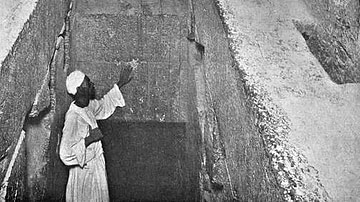
Image
Interior Passage, Great Pyramid of Giza
An interior passageway of the Great Pyramid of Giza, built during the reign of the king Khufu (2589-2566 BCE, also known as Cheops) of the 4th Dynasty, Egypt. (Photograph taken in 1910 CE)
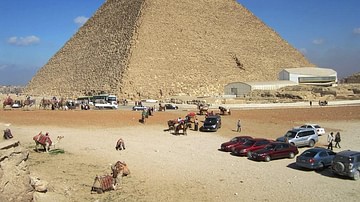
Image
Great Pyramid of Giza
The Great pyramid of Giza, built during the reign of the king Khufu (2589-2566 BCE, also known as Cheops) of the 4th Dynasty, Egypt.
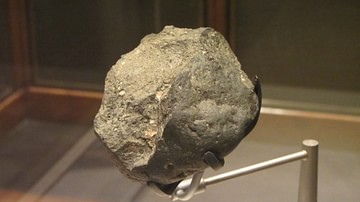
Image
Oldowan Chopper
Chopper made from basalt by early humans between 1,8 and 2 million years ago. It belongs to the Oldowan stone tool industry, was found in Olduvai Gorge, Tanzania - the place the industry is named after. Its dimensions are length: 9.29 cm...
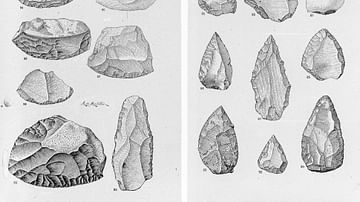
Image
Drawings of Middle Palaeolithic Tools: Points & Scrapers
Drawings of stone tools belonging to the Middle Palaeolithic (sometimes called 'Mousterian') industries, found from Europe and the Near East to Africa between approximately 250,000 and 30,000 years ago. It is associated with archaic homo...
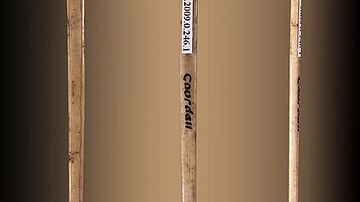
Image
Magdalenian Bone Sewing Needle
Flat bone sewing needle found at Gourdan Cave, Haute-Garonne, France. It belongs to the western European Magdalenian culture (c. 17,000 - c. 10,000 years ago) of the Late- or Upper Palaeolithic industry (c. 50,000/40,000 - c. 10,000 years...
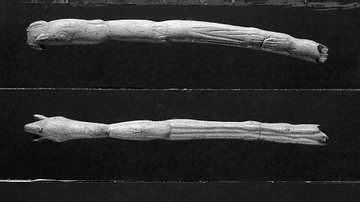
Image
Magdalenian Bone Spear Thrower
Spear thrower made out of bone and decorated with a carving of a horse's head. It belongs to the western European Magdalenian culture (c. 17,000 - c. 10,000 years ago) of the Late- or Upper Palaeolithic industry (c. 50,000/40,000 c. 10,000...
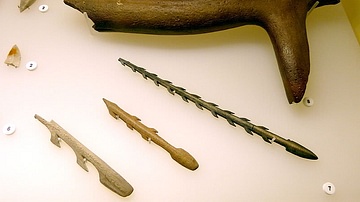
Image
Mesolithic Harpoons & Lyngby Axe
Harpoons and Lyngby Axe (an axe made of antler) dated to around the 11th millennium BCE and belonging to the Mesolithic Age. It is on display at the Archaeological Museum of the state of Brandenburg in Germany.
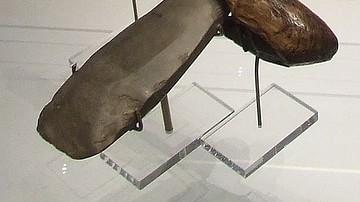
Image
Neolithic Stone Axe with Wooden Handle
A Neolithic stone axe with a wooden handle, found at Ehenside Tarn. It is on display in the British Museum, London.
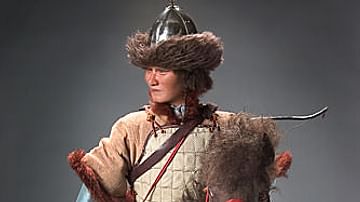
Image
Attila the Hun Model
A reconstruction potrait of Attila the Hun. (Produced by artist/historian George S. Stuart for the George S. Stuart Gallery of Historical Figures® archive).
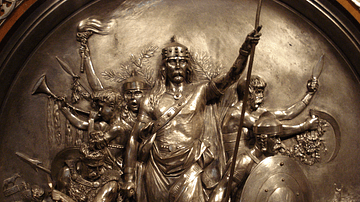
Image
Victory of Merovech at the Battle of Catalaunian Fields
A silvered bronze mount of an armoire depicting the victory of Merovingian King Merovech over the armies of Attila the Hun in 451 CE at the Battle of Catalaunian Fields. By Emmanuel Fremiet, 1867 CE (Metropolitan Museum of Art, New York)